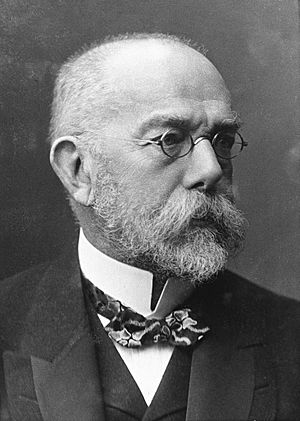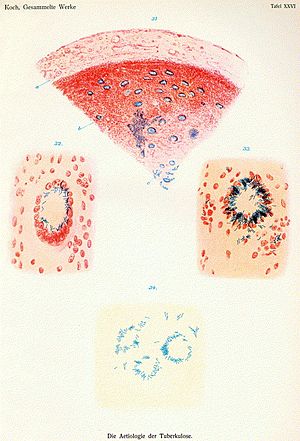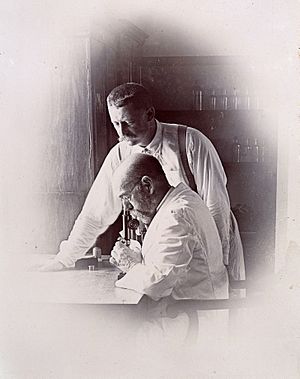Robert Koch facts for kids
Quick facts for kids
Robert Koch
|
|
|---|---|
 |
|
| Born |
Heinrich Hermann Robert Koch
11 December 1843 Clausthal, Kingdom of Hanover, German Confederation
|
| Died | 27 May 1910 (aged 66) |
| Nationality | German |
| Alma mater | University of Göttingen |
| Known for | Bacterial culture method Koch's postulates Germ theory Discovery of anthrax bacillus Discovery of tuberculosis bacillus Discovery of cholera bacillus |
| Awards |
|
| Scientific career | |
| Fields | Microbiology |
| Institutions | Imperial Health Office, Berlin University of Berlin |
| Doctoral advisor | Georg Meissner |
| Other academic advisors | Friedrich Gustav Jakob Henle Karl Ewald Hasse Rudolf Virchow |
| Influenced | Friedrich Loeffler |
Robert Koch (born December 11, 1843 – died May 27, 1910) was a German doctor and microbiologist. He discovered the tiny germs that cause serious diseases like tuberculosis, cholera, and anthrax. Because of his important work, he is known as one of the main founders of modern bacteriology, which is the study of bacteria. Many people call him the "father of microbiology" along with Louis Pasteur.
Koch's discovery of the anthrax germ in 1876 was a big step for modern bacteriology. He showed that specific germs cause specific diseases. This helped prove the germ theory, which says that tiny living things cause many illnesses. His work created the scientific basis for public health, helping to save millions of lives. Robert Koch is seen as one of the most important people in modern medicine.
While working as a private doctor, Koch created many new ways to study tiny living things. He was the first to use special lenses and photography with microscopes. He also invented a way to grow bacteria in the lab using agar and glass plates. His assistant, Julius Richard Petri, later improved this method, leading to the Petri dish we know today.
Because of his amazing work, Koch was given important jobs in the German government and at Berlin University. He also became the director of a special institute for infectious diseases, which was later named the Robert Koch Institute after him.
The methods Koch used led to a set of rules called Koch's postulates. These are four important steps to figure out if a germ causes a specific disease. Doctors still use these rules today. Koch also discovered a substance called tuberculin. At first, he thought it could cure tuberculosis, but it didn't work as a medicine. However, it later became useful for diagnosing tuberculosis. For his research on tuberculosis, he won the Nobel Prize in Physiology or Medicine in 1905. The day he announced his discovery of the tuberculosis germ, March 24, 1882, is now celebrated as "World Tuberculosis Day" every year.
Contents
Early Life and School
Robert Koch was born in Clausthal, Germany, on December 11, 1843. His father was a mining engineer. Robert was the third of thirteen children. He was very good at school from a young age. He even taught himself to read and write before starting school in 1848. He finished high school in 1862, being excellent in science and math.
When he was 19, in 1862, Koch started studying natural science at the University of Göttingen. He studied math, physics, and botany. After three semesters, he decided to switch to medicine because he wanted to be a doctor. In medical school, he did research on nerves and later on how the body produces certain chemicals. In January 1866, he graduated from medical school with the highest honors.
His Career as a Doctor and Scientist
After graduating in 1866, Koch worked as a doctor in different places. In 1870, he joined the German army as a volunteer surgeon during the Franco-Prussian War. After the war, in 1872, he became a district physician in Wollstein, which is now in Poland. His wife gave him a microscope as a birthday gift. With this microscope, he set up a small lab and began his work in microbiology.
Koch started studying tiny living things in his lab, which was connected to his patient room. Here, he made a huge discovery: he found a way to grow bacteria in the lab. He was able to separate and grow specific germs in a pure form. His discovery of the anthrax germ (called Bacillus anthracis) greatly impressed another scientist named Ferdinand Cohn. Cohn helped Koch publish his discovery in 1876.
In 1880, Koch moved to Berlin to work as a government advisor at the Imperial Health Office. After he discovered the tuberculosis germ, he was given a higher position in 1882.
In 1885, Koch became a professor at Berlin University. He was the Director of the Hygienic Institute and a Professor of hygiene. In 1891, he became the director of the Royal Prussian Institute for Infectious Diseases. This institute was later renamed the Robert Koch Institute after he passed away. In 1906, he traveled to East Africa to study a disease called trypanosomiasis (sleeping sickness).
What Robert Koch Discovered
New Ways to Study Bacteria
Robert Koch made two important improvements to microscopes. He was the first to use a special oil immersion lens and a condenser. These helped him see smaller things more clearly. He also used photography to record what he saw through the microscope. He also created ways to stain bacteria with special dyes so they could be seen better.
To grow bacteria, Koch first used slices of potato. He saw that individual groups of the same, pure cells grew on them. But potato slices didn't work for all germs. He then tried using nutrient solutions with gelatin. However, gelatin would melt at body temperature (37°C), which is the best temperature for many human germs to grow.
In 1881, his assistant's wife, Fanny Hesse, suggested using agar. Agar is a substance that stays solid at 37°C and most bacteria don't break it down. This made it a perfect clear material to grow bacteria.
The Petri Dish Story
In 1881, Koch published a book called "Methods for the Study of Pathogenic Organisms." It became known as the "Bible of Bacteriology." In this book, he described a new way to grow bacteria using glass slides with agar. He would pour liquid agar onto a glass slide, let it solidify, and then spread bacteria on it. He put this culture in a special glass container he called a "moist chamber." This chamber was a round glass dish with a lid to keep out other germs. The clear glass and culture made it easy to watch the bacteria grow.
Koch showed his new method at a medical meeting in London in 1881. Even Louis Pasteur was very impressed! Koch's students used his methods to discover new bacteria. For example, Friedrich Loeffler found the bacteria for diphtheria in 1884.
Koch's assistant, Julius Richard Petri, improved this method in 1887. He simply used the circular glass dish directly as the main container for the culture, instead of just a moist chamber. This made it even harder for other germs to get in. This improved culture plate was named the Petri dish after him.
Anthrax Research
Robert Koch is very famous for his work on anthrax. He discovered that the deadly disease was caused by a germ called Bacillus anthracis. He published this discovery in 1876. His 1877 publication showed the first photograph of a bacterium. He also found that anthrax bacteria could form tough, resting forms called spores. These spores could stay inactive for a long time but would become active and cause disease when conditions were right.
To find this germ, he would dry bacteria onto glass slides, stain them with dyes, and look at them under his microscope. His work with anthrax was very important because he was the first to clearly show that a specific tiny germ caused a specific disease. This helped prove the germ theory of disease and showed that diseases don't just appear out of nowhere.
Tuberculosis Research
While working in Berlin in the 1880s, Koch became very interested in tuberculosis. At that time, many people thought tuberculosis was passed down in families. But Koch believed it was caused by a germ and could spread from person to person. In 1882, he announced his findings: the disease was caused by a slow-growing germ called Mycobacterium tuberculosis. He presented his discovery on March 24, 1882.
Some famous scientists, like Rudolf Virchow, were doubtful at first. But others, like Paul Ehrlich, were amazed. Ehrlich later said it was his "single greatest scientific experience."
Cholera Research
In August 1883, the German government sent Koch and his team to Egypt to study a cholera outbreak. Koch found that people who died of cholera always had a bacterial infection in their intestines. When the outbreak in Egypt ended, he moved to India, where there was a more serious outbreak. He soon found that the Ganges river was a source of cholera. He examined many bodies and found the same bacteria in each one. He also found these bacteria in water tanks, linking them to the source of the infection.
He was able to grow the bacteria in a pure culture in January 1884. He saw that the bacteria were a new type, shaped "a little bent, like a comma." He thought the bacteria might produce a poison that caused the disease. Later, in 1959, an Indian scientist discovered this poison, called the cholera toxin. Koch reported his discovery in February and published it in a German medical journal the next month.
Even though Koch was sure this was the cholera germ, he couldn't fully prove that it caused the disease in healthy animals. He realized that animals might be immune to human germs. The bacterium was first called "the comma bacillus." Later, it was renamed Vibrio cholerae in 1896.
Tuberculosis Treatment and Tuberculin
Koch spent a lot of his career studying tuberculosis. He tried to find a cure. He experimented with different chemicals, but they didn't work. By 1888, he started looking at special dyes as anti-bacterial chemicals.
In 1890, he found that an extract from tuberculosis bacteria, mixed in glycerine, seemed to help guinea pigs with tuberculosis. He found that this extract didn't kill the bacteria directly. Instead, it destroyed the infected tissues, which stopped the bacteria from growing. By November 1890, Koch believed the extract also worked in humans. Many patients and doctors traveled to Berlin to get this new remedy.
However, his experiments showed that the substance caused strong reactions in infected guinea pigs and even more severe reactions in humans. This strong immune response is now called the "Koch phenomenon." The substance was called "Koch's Lymph" and later "tuberculin."
When the first reports on its use in humans came out in 1891, they were disappointing. Tuberculin was not an effective cure for tuberculosis. This was seen as Koch's "greatest failure," and his reputation suffered. But he spent the rest of his life trying to make tuberculin useful. Even though it didn't cure the disease, the substance is still used today to test if someone has been exposed to tuberculosis.
How Our Bodies Fight Sickness
Koch also observed how our bodies develop immunity (the ability to fight off sickness). In 1900, he went to German New Guinea. He studied the local people and found that many had malaria parasites in their blood, but they didn't get very sick. However, German settlers and Chinese workers who came to New Guinea got sick right away. Koch noticed that the longer these newcomers stayed in the country, the more they seemed to develop a resistance to malaria.
Koch's Postulates
During his time as a government advisor, Koch published how he found the tuberculosis germ and proved it caused the disease. He explained how important it was to grow pure cultures of germs. He also described the steps needed to do this. These steps are now known as Koch's four postulates. These rules helped doctors figure out the cause of most infectious diseases. They became the "gold standard" for studying infectious diseases.
Even though Koch developed the ideas, his assistant, Friedrich Loeffler, actually wrote down the first three postulates in 1883:
- The germ must always be found in every person who has the disease, but not in healthy people.
- The germ must be taken from a sick person and grown by itself in a lab.
- This pure germ, when put into a healthy person or animal, must cause the same disease.
The fourth postulate was added later by an American scientist in 1905:
- The same germ must be found again in the person or animal that was made sick in the experiment.
His Family and Later Life
In July 1867, Koch married Emma Fraatz, and they had a daughter named Gertrude in 1868. Their marriage ended in 1893. Later that same year, he married actress Hedwig Freiberg.
On April 9, 1910, Koch had a heart attack and never fully recovered. He died on May 27, 1910, in Baden-Baden, at the age of 66. After he died, the institute he directed was named the Robert Koch Institute in his honor.
Awards and Honors
Robert Koch received many awards for his work. He was made a Knight Grand Cross in the Prussian Order of the Red Eagle in 1890. In 1897, he became a Foreign Member of the Royal Society. In 1905, he won the Nobel Prize in Physiology and Medicine for his discoveries about tuberculosis.
In 1906, he received the Order Pour le Merite for his research on tuberculosis and tropical diseases. In 1908, the Robert Koch Medal was created to honor great doctors, and he was the first to receive it. The German Emperor also gave him the Order of the Crown, a large sum of money, and important titles.
The institute he founded in Berlin in 1891 was renamed the Robert Koch Institute after his death.
The World Health Organization celebrates "World Tuberculosis Day" every March 24. This day remembers when Koch discovered the tuberculosis bacterium in 1882.
Koch's name is one of 23 important scientists carved into the building of the London School of Hygiene & Tropical Medicine.
There is a large marble statue of Robert Koch in a park in Berlin. His life was also shown in a 1939 German movie. On December 10, 2017, Google honored his birthday with a special Google Doodle.
Koch and his relationship with Paul Ehrlich, another scientist who helped diagnose TB, were shown in the 1940 movie Dr. Ehrlich's Magic Bullet.
See also
 In Spanish: Robert Koch para niños
In Spanish: Robert Koch para niños





